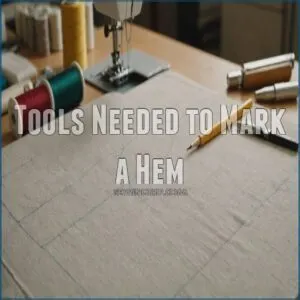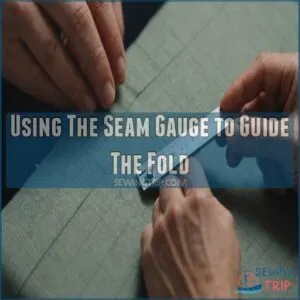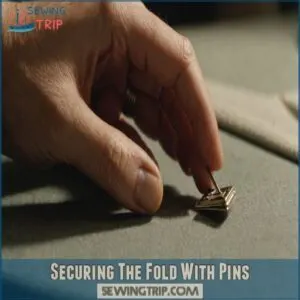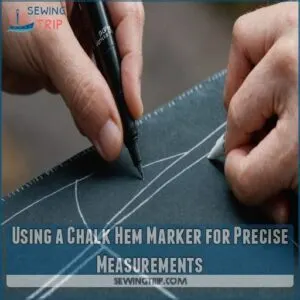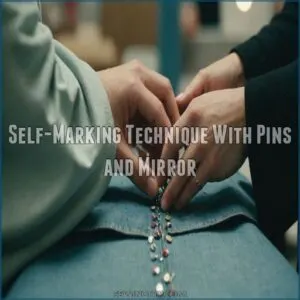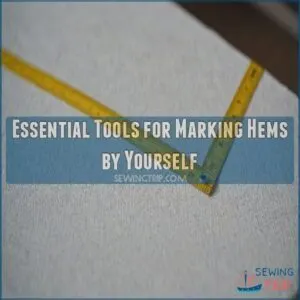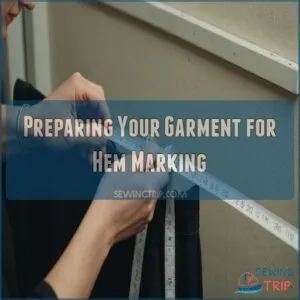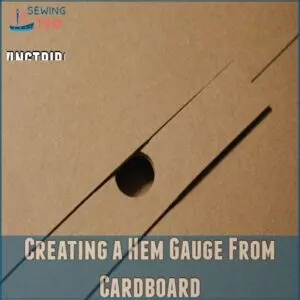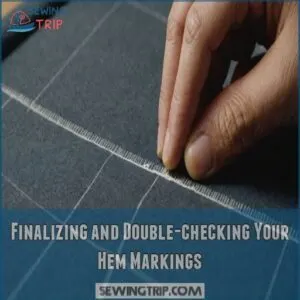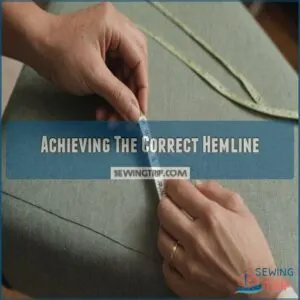This site is supported by our readers. We may earn a commission, at no cost to you, if you purchase through links.
 To mark a hem by yourself, start by trying on the garment and standing naturally—no slouching!
To mark a hem by yourself, start by trying on the garment and standing naturally—no slouching!
Use tailor’s chalk to mark where you’d like the hem. Now for the fun part: use a mirror and some patience.
Turn the garment inside out and chalk a second line about two inches below your first mark. This gives you some room to wiggle with adjustments.
Feeling like a sewing sorcerer yet? Secure the fold with straight pins or a seam gauge for precision.
By the time you’re done, you’ll have a perfectly marked hem, impressively all on your own. Ready for more DIY magic?
Table Of Contents
- Key Takeaways
- Tools Needed to Mark a Hem
- Methods to Mark a Hem Without a Tool
- Marking a Hem Using a Seam Gauge
- Using a Chalk Hem Marker for Precise Measurements
- Self-Marking Technique With Pins and Mirror
- Essential Tools for Marking Hems by Yourself
- Preparing Your Garment for Hem Marking
- Creating a Hem Gauge From Cardboard
- Finalizing and Double-checking Your Hem Markings
- Achieving The Correct Hemline
- Frequently Asked Questions (FAQs)
- Conclusion
Key Takeaways
- Use tailor’s chalk and a mirror to mark your hem accurately, ensuring a straight and even line.
- Leverage a seam gauge and pins to secure your fold and maintain precise hem allowances.
- Adjust for shoe height and natural posture to achieve a hemline that complements your outfit.
- Create a DIY cardboard hem gauge to mark consistent measurements, ensuring reliability for every project.
Tools Needed to Mark a Hem
You’ll need a few key tools to mark your hem like a pro.
Straight pins, string, a seam gauge, and chalk or a chalk hem marker will help you achieve precise measurements and clear markings for your DIY alterations, allowing you to accurately determine the new length and mark the cutting line using tailor’s chalk or fabric markers, before you start the hemming process.
Straight Pins and Strings
Two essential tools for marking a perfect hem are straight pins and string.
You’ll use these to create a guide for your hemline.
Pin placement is key for accuracy, while proper string tension guarantees evenness.
Here’s what you need to know:
- Choose fine, sharp straight pins for delicate fabrics
- Use sturdy pins for heavier materials like denim
- Opt for cotton or polyester string for durability
- Adjust string tension to prevent sagging or puckering
- Master pin spacing for a smooth, professional-looking hemline
Seam Gauge and Chalk Hem Marker
Armed with a seam gauge and chalk hem marker, you’ll be marking hems like a pro in no time.
The seam gauge helps you measure consistent hem allowances, while the chalk marker creates clear, precise lines.
These DIY hem tools are your secret weapons for accuracy.
Adjust the seam gauge to your desired length, then use the chalk marker to trace your hemline.
You’ll avoid common hem marking mistakes and achieve a perfect, even hemline every time.
Chalk and Tailor’s Chalk
While seam gauges and chalk hem markers are handy, don’t overlook the power of good old chalk.
You’ll find it’s a game-changer for marking hems.
Tailor’s chalk comes in various colors and shapes, perfect for different fabrics.
If you’re looking to expand your sewing toolkit, consider investing in sewing tools to buy sooner, which can help take your projects to the next level.
Here’s why it’s a must-have:
- Easy to use on most fabrics
- Brushes off easily, leaving no residue
- Allows for precise, thin lines
Store your chalk in a cool, dry place to keep it in tip-top shape for your next hemming adventure.
Methods to Mark a Hem Without a Tool
You don’t need fancy tools to mark a perfect hem; your ingenuity is enough.
With everyday items like string and chalk, you can create professional-looking hems that’ll make your clothes fit like a glove.
Using a Chalked String Method
You’ve got your tools, now let’s get creative with a chalked string method.
This DIY technique is a game-changer for marking hems without fancy gadgets.
Here’s how to nail it:
| Step | Action |
|---|---|
| 1 | Coat string with chalk |
| 2 | Hang string at desired height |
| 3 | Brush garment against string |
| 4 | Press and sew along chalk line |
It’s like playing connect-the-dots, but for your clothes!
This method gives you pinpoint accuracy and works wonders for tricky fabrics.
Measuring From The Floor Up
Forget the chalked string – let’s talk floor-to-hem measurements.
Grab a trusty ruler and place it vertically against the floor.
Mark your desired hem length on the garment, then repeat this process at several points around the fabric.
Connect these marks with pins or chalk, creating a consistent hemline.
This method’s a lifesaver for those tricky fabrics that don’t play nice with horizontal marking techniques.
Adjusting for Curved or Uneven Hems
Curved or uneven hems can throw a wrench in your DIY plans.
For these tricky edges, ditch the straight ruler and embrace flexibility.
Use a flexible curve ruler or drape a string along the fabric’s edge.
Mark small dots at regular intervals, then connect them with a gentle curve.
This method guarantees your hem follows the garment’s natural shape, giving you a polished finish that looks tailor-made.
Marking a Hem Using a Seam Gauge
A seam gauge is your secret weapon for marking hems with precision and ease.
You’ll use this handy tool to guide your folds and create accurate, consistent markings.
These markings will make your DIY alterations look professional.
Folding The Garment to Desired Length
To fold your garment to the desired length, start by putting on the shoes you’ll wear with it.
Stand straight and pinch the fabric at your preferred hem length.
To achieve precise folds, consider using a sewing gauge tool to help you measure accurate hem widths.
For a polished look, consider these factors:
- Pant drape: Make sure it falls naturally
- Fabric stretch: Account for movement
- Shoe height: Match your everyday footwear
- Hem allowance: Leave room for adjustments
Fold the fabric carefully, keeping an eye on the overall silhouette.
This important step sets the foundation for your DIY garment alterations.
Using The Seam Gauge to Guide The Fold
With your garment folded, grab your seam gauge to guarantee precision.
This handy tool is your secret weapon for consistent hems.
Adjust the slider to your desired hem allowance, then run it along the fold.
It’s like having a mini-ruler that hugs your fabric!
Different fabrics may require adjustments, so keep that in mind as you work.
| Fabric Type | Seam Gauge Setting |
|---|---|
| Denim | 1 inch |
| Silk | 1/2 inch |
| Cotton | 3/4 inch |
| Wool | 1 1/4 inch |
Securing The Fold With Pins
Now that you’ve got your fold in place, it’s time to lock it down.
Grab those pins and get ready to secure your hem like a pro.
To make sure your folds are accurate, consider using a seam gauge with seam gauge pins.
Here’s how to nail the pin placement:
- Start at the side seams, working your way around
- Space pins about 2-3 inches apart for even hem security
- Use fine, sharp pins to avoid fabric damage
- Pin perpendicular to the fold for easy removal
- Double-check pin placement before moving on to sewing
Using a Chalk Hem Marker for Precise Measurements
You’ll find that using a chalk hem marker is like having a professional tailor at your fingertips.
This handy tool allows you to adjust the marker’s height and apply precise chalk lines around your garment, ensuring an even hemline on all sides.
Adjusting The Hem Marker to Desired Length
Got your chalk hem marker? Let’s dial in that perfect length.
You can find a great one here to help you with your DIY project.
Slide the ruler to your desired hem height and lock it in place.
Double-check the measurement – you want spot-on accuracy for pro-level results.
Make sure the marker’s stable; a wobbly tool leads to wonky hems.
For pants alterations, remember to factor in shoe height.
Your DIY hemming adventure‘s off to a great start!
Applying Chalk Marks Around The Garment
You’re ready to make your mark.
To achieve precise measurements, consider using a tool with water-soluble ink like Dritz Mark-B-Gone Marking Pen, as it’s ideal for pattern transfers and intricate designs.
Hold the chalk hem marker perpendicular to the floor and gently squeeze the bulb.
As you walk around the garment, a fine line of chalk dust will appear. Keep your pace steady and your hand light for a crisp, even line.
Remember, you’re painting your path to tailoring success, so take your time and enjoy the process.
Ensuring Even Marking on All Sides
After marking one side, rotate your garment slowly, keeping the chalk marker at the same height.
This makes for a consistent hemline all around.
For curved hems, like on trousers, take extra care.
Use pins to check for evenness before sewing.
- Maintain consistent pressure on the marker.
- Check frequently for even spacing of the chalk line.
- Adjust your grip as needed for curves.
- Use a measuring tape to double-check your markings.
Self-Marking Technique With Pins and Mirror
For a hassle-free hemming process, try putting on your garment inside-out and pinning the desired hemline while wearing it.
Use a mirror to make sure your pins are even and adjust as necessary for a polished finish.
Putting on The Garment Inside-out
So, you’ve marked your hem with chalk.
Now, let’s talk about putting on the garment inside-out for self-marking, remembering that smart people don’t skip pinning when it comes to achieving accurate and even hems.
You’ll need a mirror to see how things line up. This technique helps make sure a perfect adjustment.
Check out this quick guide:
| Step | Description |
|---|---|
| 1 | Wear garment inside-out |
| 2 | Stand in front of mirror |
| 3 | Make sure the hem is even |
| 4 | Make necessary adjustments |
| 5 | Prepare for pinning |
Pinning The Desired Hemline While Wearing
Slipping into the garment inside-out sets the stage for pinning.
You can find a variety of straight pins at quality sewing pins.
With the mirror as your trusty sidekick, follow these steps to achieve the perfect hemline:
- Stand straight and hold the fabric at your desired length.
- Pin each side symmetrically for consistent dress hems.
- Use straight pins to secure your hem, ensuring an even, no-sew hem finish.
Adjusting Pins for Evenness in The Mirror
Do a visual check in the mirror to tweak your pin placement for an even hemline.
Use a string or level for precision.
Adjust pins slowly, making sure they’re aligned by making mirror adjustments.
Think of your pins as tiny helpers securing your mastery in home sewing.
This method guarantees a polished look, saving you future hemming headaches.
Essential Tools for Marking Hems by Yourself
To mark a hem like a pro, you need the right tools in your arsenal.
Essential items include a measuring tape and ruler for precise measurements, along with tailor’s chalk or fabric markers for clear lines.
Don’t forget pins and an ironing board for finishing touches.
Measuring Tape and Ruler
Imagine gearing up for a hemming task. A measuring tape and ruler are must-have tools for their precision. With these in hand, you’ll breeze through measuring fabric, tracing curves, and guaranteeing accurate hem lines.
- Measuring tape accuracy: Essential for precise hems.
- Ruler types: Choose straight or flexible for curves.
- Measuring fabric: Ensure consistent dimensions.
Tailor’s Chalk or Fabric Markers
Now that you’ve measured with your trusty tape measure and ruler, let’s talk about marking your hem.
Tailor’s chalk creates a temporary, easily erasable line, perfect for most fabrics.
Fabric markers offer a bolder, more permanent mark, ideal for darker materials.
Consider the fabric type and your preference when choosing between chalk vs. markers.
Remember, a neat hemline is within your reach!
Pins and Pincushion
After chalking up your fabric like a pro, turn to pins and pincushions, essential in keeping everything in place.
Considering options like pearl-headed pins and clips, consider various pin types for different fabrics.
Remember pin placement precision is key.
Magnetic pincushions make retrieval a breeze, ensuring no lost pins underfoot.
Taking care of your pincushion extends its life, maintaining your sewing efficiency.
Iron and Ironing Board
Once your pins secure the hem, it’s time to activate your iron and ironing board.
Make sure the iron temperature suits your fabric.
Consider these tips:
- Ironing board types: Choose one with stability for ease.
- Pressing vs ironing: Press, don’t iron, to maintain fabric shape.
- Steam vs dry: Use steam sparingly to avoid unwanted fabric changes.
Preparing Your Garment for Hem Marking
Before marking your hem, measure the ideal length by wearing the garment with the shoes you’ll pair it with and consider its style.
Account for factors like fabric type and shrinkage to achieve a precise and polished finish.
Determining The Ideal Hem Length
Figuring out the ideal hem length can feel a bit like piecing together a puzzle.
Start by considering your shoe type; heels or flats can dramatically change the look.
Watch for fabric shrinkage with new items—wash before hemming.
As you stand straight, check how the hem complements your body shape for a flattering finish.
| Aspect | Consideration | Impact |
|---|---|---|
| Shoe Type | Heels or Flats | Alter hem positioning |
| Body Shape | Proportions | Enhances appearance |
| Fabric Shrinkage | Pre-wash | Prevents re-hemming |
Considering Garment Type and Style
Choosing how to hem pants, skirts, dresses, shirts, or jackets relies on their style and fabric, and it’s also important to consider factors like hem allowance, which typically ranges from 1 to 2.5 inches depending on the blind hem techniques.
Consider these points:
- Fabric Type: Thick materials like denim need more allowance.
- Garment Style: Flowy dresses require even hemlines.
- Length Preferences: Think about fashion trends and personal taste.
- Usage Scenarios: Casual vs. formal settings affect your approach.
Accounting for Shoe Height
Before marking your hem, think about the shoes you’ll pair with your outfit.
Different shoe types can change how your pant leg drapes.
High heels can lengthen your legs, while flats might require an ankle height adjustment.
When determining the new hem length, try on the pants with the shoes to see how they fall, as described in the how to hem pants by hand, and then use a hem length guide to make sure the shoe height impact doesn’t throw off your look.
It’s a simple, yet important, step!
Creating a Hem Gauge From Cardboard
Want a perfectly even hem every time? You can easily make a reusable hem gauge from a sturdy piece of cardboard, ensuring consistent measurements for all your sewing projects.
Measuring and Cutting a Cardboard Strip
You’ve laid out the foundation of your hem plan.
Now, let’s craft a hem gauge using cardboard.
Choose a cardboard strip size that’s easy to handle, and make sure you have consistent measurements by cutting evenly.
Opt for a thickness you can comfortably manipulate.
With this DIY hem tool, measuring accuracy is a snap, making alterations stress-free and precise.
Marking Measurements on The Cardboard Gauge
To ensure cardboard gauge accuracy, leave guesswork behind with DIY measuring tools.
First, measure and mark evenly spaced lines on your cardboard strip.
Think of it as crafting a custom gauge creation for hem marking techniques.
Use a pencil to draw precise lines, providing fabric marking tips without complication.
Using techniques such as applying hemming tape, can help you achieve a professional-looking hem. This method boosts confidence in achieving perfect hems every time.
Using The DIY Gauge to Mark The Hem
To mark your hem with precision, unfold your DIY cardboard gauge.
Align the gauge’s edge with the fabric’s bottom. Glide smoothly around your garment, ensuring hem line accuracy and avoiding common DIY hemming mistakes.
Consider using this homemade hem tool for reliable results every time, proving that cardboard gauge alternatives can truly save the day in DIY fashion adjustments.
Finalizing and Double-checking Your Hem Markings
As you wrap up marking your hem, make sure the chalk marks connect smoothly to form a continuous line, giving you a clear path to follow.
Double-check the evenness of the hem by examining each side carefully, making any necessary adjustments before preparing it for sewing or alterations.
Connecting Chalk Marks to Form a Continuous Line
Once your cardboard hem gauge is ready, start connecting each chalk mark into a continuous line.
This process, called Hem Smoothing Techniques, helps guarantee Hemline Consistency and gives control over those pesky chalk marks.
To avoid hiccups, use Chalk Line Adjustments, especially on curves.
It’s like drawing a treasure map where every line leads to perfect hemlines.
Verifying Hem Evenness and Adjusting if Necessary
Balancing your hemline is key for a polished finish. Use these steps to guarantee evenness:
- Check all Even Hem Marks, spotting any inconsistencies with folding techniques.
- Conduct Hemming Troubleshooting by comparing the garment’s alignment with a ruler.
- Adjust by lifting or lowering areas until Sewing Alignment is seamless. Remember, precision in this stage makes all the difference.
Preparing The Marked Hem for Sewing or Alterations
Before sewing, make sure your marked hem is spot on. Double-check that the hem allowance is consistent, as uneven hemlines don’t charm anyone.
Use cutting techniques to trim excess fabric neatly. Ironing methods matter—press the fold to settle the fabric.
A good seam finishing technique keeps everything tidy. Voilà, you’re ready to sew with confidence!
Achieving The Correct Hemline
To achieve the perfect hemline, wear the shoes you plan to pair with the garment and maintain a natural posture.
This makes sure the fabric hangs correctly, allowing you to mark a straight and even hemline without any creases or unevenness.
Wearing The Correct Shoes
Getting the perfect hemline starts with the right footwear.
Your Shoe to Hem Ratio is key; consider heel height and sole thickness.
High heels dramatically change the hemline, while flats require a shorter hem.
The Shoe Style Impact is significant; boots might need a longer hem than sandals.
Remember, you want the hem to graze the top of your shoes, not puddle on the floor.
Mastering this simple step guarantees a professional finish.
Hemming for flats is easy if you follow this advice.
Maintaining a Natural Posture
Imagine you’re a tree, firmly rooted while achieving perfect posture for your hemline.
Stand straight with body alignment and spinal awareness, as if balancing a book on your head.
Let your hips relax naturally. Comfortable shoes are key—they help you find that sweet spot between rigidity and ease.
This stance guarantees your hem looks flawless when you step out.
Ensuring a Straight and Even Hemline
Straighten up, you’ve nailed your posture. Now, achieve a straight and even hemline with these tips.
Use Floor Length Marking for accuracy: 1. Mark with a seam gauge for Hemline Variations.
- Pin strategically, especially on Curved Hem Solutions.
Handle Hemming Thick Fabrics carefully—pins might need extra oomph.
Always keep an eye out for Troubleshooting Uneven Hems.
Frequently Asked Questions (FAQs)
How to mark a hem?
Marking a hem is simple.
Use chalk and a string at your desired height, ensuring it’s level, then rotate your garment against it.
Press along the line before sewing to keep your hem straight and even.
Can You Hem a garment by yourself?
With a dash of creativity and a sprinkle of patience, you can hem a garment yourself!
Use tools like a seam gauge and pins for precise results.
Follow step-by-step instructions to guarantee a professional, polished finish.
How to make a perfect Hem?
Creating a perfect hem starts with marking it accurately using tools like chalk or a seam gauge.
Fold and pin the fabric securely, make sure it’s even, and press for a professional finish before sewing with matching thread.
How do you sew a hemline?
To sew a hemline, fold the fabric to the desired length, pin it in place.
When learning basic and advanced sewing techniques for garment creation, it’s essential to choose the right machine, such as a mechanical or computerized sewing machine essentials. Use a sewing machine or hand stitch.
Choose a straight stitch for a machine or a slip stitch for hands.
How do you mark the hem of a dress to hem it?
Let’s tackle that hemline! Grab some pins and tailor’s chalk. Measure your desired length, mark it, and then pin along the line. You’re ready to sew a perfect hem!
How to make a hem if you don’t have strings?
Use a seam gauge instead of a string to make a hem.
Fold the garment up, measure with the gauge, and pin it in place.
Adjust the blue slide to mark hem allowance, ensuring accuracy and consistency.
How do I mark a curved hemline?
Marking a curved hemline involves using a flexible tape measure and chalk.
Measure consistently around the curve, marking small dots at equal intervals.
Connect these dots smoothly with chalk, ensuring the curve is even before starting to sew.
Can I use washable markers for hemming?
You can certainly use washable markers for hemming as a temporary solution.
They’re great for quick fixes because marks easily wash out.
Just make sure the marker color contrasts with your fabric for better visibility when sewing.
What if my fabric is very thick?
When you’re tackling thick fabric, like denim, craft a sturdy hem by carefully folding and pressing each layer.
Secure with strong pins and sew with a robust needle and thread, ensuring a clean, even line every time.
How to hem uneven fabric edges?
Hemming uneven fabric edges involves trimming any excess fabric, then folding up the edge evenly.
Use pins to secure the fold.
Should I pre-wash fabric before hemming?
Pre-washing fabric before hemming is smart.
It helps prevent unexpected shrinking or color bleeding later.
Just imagine your perfectly hemmed piece shrinking after a wash!
Pre-washing guarantees that hems stay even and garments fit perfectly.
Conclusion
Now you’ve mastered the art of how to mark a hem by yourself!
Remember, a perfectly marked hem is the foundation of a great alteration.
Take your time, double-check your measurements, and don’t be afraid to adjust.
You’ve got this!
With practice, marking a hem will become second nature.
Soon, you’ll be confidently creating professional-looking hems on all your favorite garments.
So grab your chalk, pins, and measuring tape, and get ready to transform your wardrobe with your newfound DIY skills.
Mastering how to mark a hem by yourself opens up a world of clothing customization possibilities!

